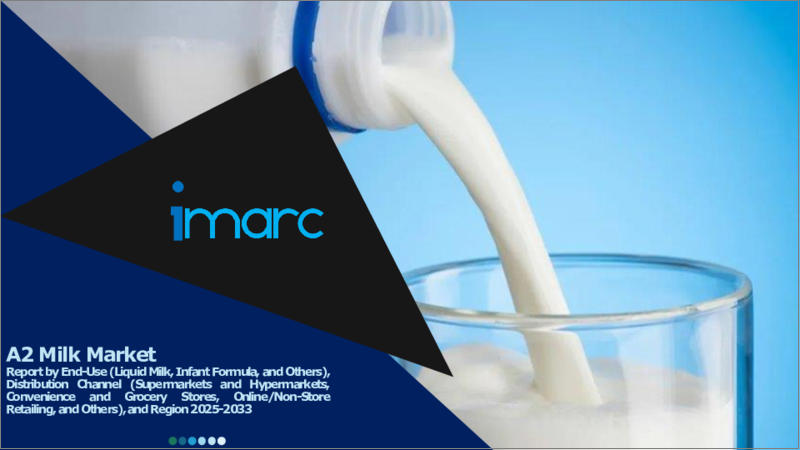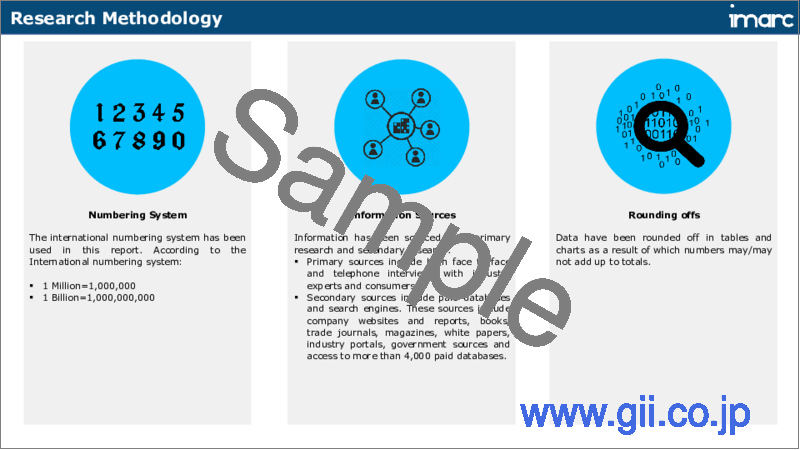|
|
市場調査レポート
商品コード
1661084
A2ミルク市場レポート:最終用途別、流通チャネル別、地域別、2025年~2033年A2 Milk Market Report by End-Use (Liquid Milk, Infant Formula, and Others), Distribution Channel (Supermarkets and Hypermarkets, Convenience and Grocery Stores, Online/Non-Store Retailing, and Others), and Region 2025-2033 |
||||||
カスタマイズ可能
|
|||||||
| A2ミルク市場レポート:最終用途別、流通チャネル別、地域別、2025年~2033年 |
|
出版日: 2025年02月10日
発行: IMARC
ページ情報: 英文 133 Pages
納期: 2~3営業日
|
全表示
- 概要
- 図表
- 目次
A2ミルク市場の世界市場規模は2024年に154億米ドルに達しました。今後、IMARC Groupは、市場は2033年までに509億米ドルに達し、2025年から2033年にかけて14.21%の成長率(CAGR)を示すと予測しています。乳糖不耐症人口の増加、A2ミルクをベースとした加工食品やRTE食品への志向の高まり、カフェやベーカリーなどの商業施設の増加が、市場を推進している主な要因の一部です。
A2ミルクは通常のミルクとは異なり、βカゼインタンパク質のA2変異体のみを含みます。ガーンジー種、リムーザン種、シャロレー種、ジャージー種などの高齢牛から搾乳されます。カルシウム、ビタミンD、タンパク質、健康的な脂肪、リン、カリウム、その他の必須栄養素を豊富に含みます。普通の牛乳を飲むと不快感を感じる人には、消化しやすいです。消化の快適性を高め、栄養の吸収を促進し、自己免疫疾患、心臓病、免疫反応障害、神経障害の開発リスクを軽減します。
乳糖不耐症人口の増加が、世界中で日々の栄養ニーズを満たすA2ミルク需要を牽引しています。さらに、急速な都市化、多忙なライフスタイル、消費者の購買力の向上などを背景に、パンケーキ、マフィン、カップケーキ、スムージー、シェイク、コーヒーなど、A2ミルクをベースとした加工食品や調理済み食品(RTE)への志向が高まっていることも、市場の成長を後押ししています。さらに、カフェ、レストラン、ホテル、クイック・サービス・レストラン(QSR)、ベーカリーなど、飲食品の調理にA2ミルクの使用を取り入れる商業施設の増加が市場にプラスの影響を与えています。これとは別に、食料品店や食品宅配アプリケーションのようなさまざまなオンライン小売チャネルを通じてA2ミルクやA2ミルクベースの食品および飲料が簡単に入手できるようになり、利便性や迅速かつ無料な配送設備が提供されるようになったことも、市場の成長に寄与しています。さらに、ローション、クレンジング、モイスチャライザー、シャンプー、コンディショナーなどの化粧品やスキンケア製品の生産におけるA2ミルクの使用の増加が、市場の成長を後押ししています。
A2ミルク市場傾向/促進要因:
関連するメリットに対する意識の高まり
A2ミルク需要を促進する主な要因のひとつは、その健康上の利点に対する消費者の意識の高まりです。A1とA2の両方のβカゼインタンパク質を含む通常の牛乳とは異なり、A2牛乳はA2βカゼインのみを含みます。調査によると、A2牛乳は人によっては消化しやすく、乳糖不耐症や牛乳過敏症に伴う症状を軽減できる可能性があります。この健康上の利点は様々なメディアを通じて効果的に伝えられ、消費者のA2ミルクに対する関心の高まりとそれに伴う需要の増加につながった。
生活習慣病の増加
肥満、糖尿病、心臓病など生活習慣に関連した健康問題が増加しているため、消費者は食生活の選択にますます慎重になっています。A2牛乳は消化器系の問題や炎症に関連するA1タンパク質を含んでいないため、通常の牛乳に代わる健康的な牛乳と見なされることが多いです。人々がバランスの取れたライフスタイルに沿った、より良い栄養価の高い選択肢を求める中、A2ミルクは人気が高まっており、健康志向の食品に対する消費者のニーズを満たしています。
消費者の嗜好の高まり
消費者の嗜好がナチュラル、オーガニック、エシカルな選択肢へと進化するにつれ、A2ミルクへの注目も高まっています。多くのA2ミルクブランドは、消化に優しいだけでなく、環境に配慮した方法で生産されていることをアピールしています。中には、放し飼いや牧草飼育など、より良い動物福祉の実践を強調するものもあり、持続可能性や倫理的配慮を重視する消費者層にアピールしています。この傾向は、健康志向の消費傾向とも一致しており、人々は健康や地球にとってより良いと思われる製品に割高な対価を支払うことを厭わないです。この動向が続くにつれ、A2ミルクの需要は上昇基調を維持すると思われます。
目次
第1章 序文
第2章 調査範囲と調査手法
- 調査の目的
- ステークホルダー
- データソース
- 一次情報
- 二次情報
- 市場推定
- ボトムアップアプローチ
- トップダウンアプローチ
- 調査手法
第3章 エグゼクティブサマリー
第4章 イントロダクション
- 概要
- 主要業界動向
第5章 世界のA2ミルク市場
- 市場概要
- 市場実績
- 数量動向
- 金額動向
- COVID-19の影響
- 市場内訳:最終用途別
- 市場内訳:流通チャネル別
- 市場内訳:地域別
- 市場予測
- SWOT分析
- 概要
- 強み
- 弱み
- 機会
- 脅威
- バリューチェーン分析
- 概要
- 研究開発
- 原材料調達
- 製造
- マーケティング
- 流通
- 最終用途
- ポーターのファイブフォース分析
- 概要
- 買い手の交渉力
- 供給企業の交渉力
- 競合の程度
- 新規参入業者の脅威
- 代替品の脅威
- 価格分析
- 主要価格指標
- 価格構造
- マージン分析
- 市場促進要因と成功要因
第6章 市場内訳:最終用途別
- 液体ミルク
- 乳児用調製粉乳
- その他
第7章 市場内訳:流通チャネル別
- スーパーマーケットとハイパーマーケット
- コンビニエンスストアと食料品店
- オンライン/非店舗小売
- その他
第8章 主要地域の実績
- アジア太平洋地域
- 北米
- 欧州
- 中東・アフリカ
- ラテンアメリカ
第9章 競合情勢
- 市場構造
- 主要企業
- 主要企業のプロファイル
- The A2 Milk Company Limited
- Jersey Dairy
- Lion Pty Limited(Pura and Dairy Farmers)
- Fonterra
List of Figures
- Figure 1: Global: A2 Milk Market: Major Drivers and Challenges
- Figure 2: Global: A2 Milk Market: Sales Volume (in Million Tons), 2019-2024
- Figure 3: Global: A2 Milk Market: Sales Value (in Billion USD), 2019-2024
- Figure 4: Global: A2 Milk Market: Breakup by End-Use (in %), 2024
- Figure 5: Global: A2 Milk Market: Breakup by Distribution Channel (in %), 2024
- Figure 6: Global: A2 Milk Market: Breakup by Region (in %), 2024
- Figure 7: Global: A2 Milk Market Forecast: Sales Volume (in Million Tons), 2025-2033
- Figure 8: Global: A2 Milk Market Forecast: Sales Value (in Billion USD), 2025-2033
- Figure 9: Global: A2 Milk Industry: SWOT Analysis
- Figure 10: Global: A2 Milk Industry: Value Chain Analysis
- Figure 11: Global: A2 Milk Industry: Porter's Five Forces Analysis
- Figure 12: Liquid Milk Market (Produced from A2 Milk): Price Structure (in %)
- Figure 13: Global: Liquid Milk Market (Produced from A2 Milk): Sales Value (in Million USD), 2019 & 2024
- Figure 14: Global: Liquid Milk Market Forecast (Produced from A2 Milk): Sales Value (in Million USD), 2025-2033
- Figure 15: Global: Infant Formula Market (Produced from A2 Milk): Sales Value (in Million USD), 2019 & 2024
- Figure 16: Global: Infant Formula Market Forecast (Produced from A2 Milk): Sales Value (in Million USD), 2025-2033
- Figure 17: Global: Other Dairy Products Market (Produced from A2 Milk): Sales Value (in Million USD), 2019 & 2024
- Figure 18: Global: Other Dairy Products Market Forecast (Produced from A2 Milk): Sales Value (in Million USD), 2025-2033
- Figure 19: Global: A2 Milk Market: Sales through Supermarkets and Hypermarkets (in Million USD), 2019 & 2024
- Figure 20: Global: A2 Milk Market Forecast: Sales through Supermarkets and Hypermarkets (in Million USD), 2025-2033
- Figure 21: Global: A2 Milk Market: Sales through Convenience and Grocery Stores (in Million USD), 2019 & 2024
- Figure 22: Global: A2 Milk Market Forecast: Sales through Convenience and Grocery Stores (in Million USD), 2025-2033
- Figure 23: Global: A2 Milk Market: Sales through Online/Non-store Retailing (in Million USD), 2019 & 2024
- Figure 24: Global: A2 Milk Market Forecast: Sales through Online/Non-store Retailing (in Million USD), 2025-2033
- Figure 25: Global: A2 Milk Market: Sales through Other Distribution Channels (in Million USD), 2019 & 2024
- Figure 26: Global: A2 Milk Market Forecast: Sales through Other Distribution Channels (in Million USD), 2025-2033
- Figure 27: North America: A2 Milk Market: Sales Value (in Million USD), 2019 & 2024
- Figure 28: North America: A2 Milk Market Forecast: Sales Value (in Million USD), 2025-2033
- Figure 29: Europe: A2 Milk Market: Sales Value (in Million USD), 2019 & 2024
- Figure 30: Europe: A2 Milk Market Forecast: Sales Value (in Million USD), 2025-2033
- Figure 31: Oceania: A2 Milk Market: Sales Value (in Million USD), 2019 & 2024
- Figure 32: Oceania: A2 Milk Market Forecast: Sales Value (in Million USD), 2025-2033
- Figure 33: Asia: A2 Milk Market: Sales Value (in Million USD), 2019 & 2024
- Figure 34: Asia: A2 Milk Market Forecast: Sales Value (in Million USD), 2025-2033
- Figure 35: Others: A2 Milk Market: Sales Value (in Million USD), 2019 & 2024
- Figure 36: Others: A2 Milk Market Forecast: Sales Value (in Million USD), 2025-2033
List of Tables
- Table 1: Global: A2 Milk Market: Key Industry Highlights, 2024 and 2033
- Table 2: Global: A2 Milk Market Forecast: Breakup by End-Use (in Million USD), 2025-2033
- Table 3: Global: A2 Milk Market Forecast: Breakup by Distribution Channel (in Million USD), 2025-2033
- Table 4: Global: A2 Milk Market Forecast: Breakup by Region (in Million USD), 2025-2033
- Table 5: Global: A2 Milk Market: Competitive Structure
- Table 6: Global: A2 Milk Market: Key Players
The global A2 milk market size reached USD 15.4 Billion in 2024. Looking forward, IMARC Group expects the market to reach USD 50.9 Billion by 2033, exhibiting a growth rate (CAGR) of 14.21% during 2025-2033. The increasing lactose intolerant population, rising inclination towards A2 milk-based processed and RTE food products, and the growing number of commercial establishments, including cafes and bakeries, are some of the major factors propelling the market.
A2 milk contains only the A2 variant of beta-casein protein, unlike regular milk. It is sourced from older cow breeds, including Guernsey, Limousin, Charolais, and Jersey. It is rich in calcium, vitamin D, protein, healthy fats, phosphorus, potassium, and other essential nutrients. It is easier to digest for people who experience discomfort when consuming regular milk. It aids in improving digestive comfort, enhancing nutrient absorption, and reducing the risk of developing autoimmune diseases, heart diseases, impaired immune responses, and neurological impairment.
The increasing lactose intolerant population is driving the demand for A2 milk to meet the daily nutritional needs of the body around the world. Moreover, the rising inclination towards A2 milk-based processed and ready to eat (RTE) food products, such as pancakes, muffins, cupcakes, smoothies, shakes, and coffee, on account of rapid urbanization, busy lifestyles, and improving purchasing power of consumers is favoring the growth of the market. In addition, the growing number of commercial establishments, including cafes, restaurants, hotels, quick service restaurants (QSRs), and bakeries, which are incorporating the use of A2 milk in the preparation of food and beverages is influencing the market positively. Apart from this, the easy availability of A2 milk and A2 milk based food products and drinks via different online retail channels like grocery or food delivery applications, as they offer convenience and fast and free shipping facilities, are contributing to the market growth. Furthermore, increasing use of A2 milk in the production of cosmetic and skincare products, such as lotions, cleansers, moisturizers, shampoos, and conditioners, are bolstering the market growth.
A2 Milk Market Trends/Drivers:
Increase in awareness about associated benefits
One of the primary factors driving the demand for A2 milk is the growing consumer awareness about its health benefits. Unlike regular cow's milk, which contains both A1 and A2 beta-casein proteins, A2 milk contains only A2 beta-casein. Research has indicated that A2 milk is easier to digest for some individuals, potentially reducing symptoms associated with lactose intolerance and milk sensitivities. This perceived health advantage has been communicated effectively through various media channels, leading to increased consumer interest and subsequent demand for A2 milk.
Rise in lifestyle diseases
With lifestyle-related health issues such as obesity, diabetes, and heart disease on the rise, consumers are becoming increasingly cautious about their dietary choices. A2 milk is often seen as a healthier alternative to regular milk because it lacks the A1 protein, which has been linked to some digestive issues and inflammation. As people look for better and nutritious options that align with a balanced lifestyle, A2 milk is gaining popularity, fulfilling this consumer need for wellness-focused food products.
Growing consumer preferences
As consumer preferences evolve toward natural, organic, and ethical choices, A2 milk is enjoying increased attention. Many A2 milk brands promote their products as not only easier on digestion but also produced in environmentally responsible ways. Some even highlight better animal welfare practices, like free-range and grass-fed cows, which appeal to a consumer base concerned with sustainability and ethical considerations. This aligns with the broader trend of health-conscious consumption, wherein people are willing to pay a premium for products that they perceive to be better for their health and the planet. As this trend continues, the demand for A2 milk is likely to sustain its upward trajectory.
A2 Milk Industry Segmentation:
Breakup by End-Use:
- Liquid Milk
- Infant Formula
- Others
Liquid milk dominates the market
A2 milk is increasingly being used in the formulation of infant formula products. Some parents opt for A2 infant formula to provide nutrition that may be easier on digestive system of infants. The formula is designed to be a balanced source of nutrients for babies, including essential fatty acids, vitamins, and minerals, and aims to mimic the nutritional profile of natural breast milk as closely as possible. A2 infant formula is generally used as a supplement to or replacement for breast milk for babies who may be lactose intolerant or sensitive to the A1 protein found in regular cow's milk-based formulas.
Breakup by Distribution Channel:
- Supermarkets and Hypermarkets
- Convenience and Grocery Stores
- Online/Non-store Retailing
- Others
Supermarkets and hypermarkets holds the largest share in the market
Convenience and grocery stores offer another significant distribution channel for A2 milk. These stores are generally smaller and more localized compared to supermarkets and hypermarkets. They serve as a quick and convenient option for consumers to purchase essential items, including milk. A2 milk can benefit from the impulse-buying behavior often seen in these stores. Additionally, the local nature of convenience and grocery stores allows for more targeted distribution, catering to neighborhoods or areas where there may be higher demand for specialized dairy products like A2 milk. These smaller stores can also provide opportunities for in-store promotions and personalized customer engagement.
Breakup by Region:
- North America
- Europe
- Oceania
- Asia
- Others
Oceania exhibits a clear dominance, accounting for the largest A2 milk market share
The market research report has also provided a comprehensive analysis of all the major regional markets, which include North America, Europe, Oceania, Asia, and others. According to the report, Oceania accounted for the largest market share.
The increasing consumption of dairy-free and lactose-free products represents one of the primary factors driving the demand for A2 milk in the Oceania region. Moreover, the rising health concerns among consumers is favoring the growth of the market in the region. Besides this, the growing use of A2 milk in the manufacturing of baby food and infant formula is influencing the market positively in the region.
Competitive Landscape:
The leading companies are using genetic testing to identify cows that produce A2-only protein, which ensures that the milk is genuinely of the A2 variety and maintains the integrity of the product. They are also utilizing mass spectrometry and advanced chromatography technologies for stringent quality checks, which help in confirming the absence of A1 proteins and ensuring the purity of A2 milk. Moreover, key players are integrating blockchain technology and QR codes to enhance traceability and allow consumers to access detailed information about the journey of the product from farm to shelf, thereby increasing consumer trust. They are also ensuring that A2 milk maintains its quality while being transported over long distances.
The report has provided a comprehensive analysis of the competitive landscape in the market. Detailed profiles of all major companies have also been provided. Some of the key players in the market include:
- The A2 Milk Company Limited
- Jersey Dairy
- Lion Pty Limited (Pura and Dairy Farmers)
- Fonterra
Key Questions Answered in This Report
- 1.What is the size of the global A2 milk market in 2024?
- 2.What is the expected growth rate of the global A2 milk market during 2025-2033?
- 3.What are the key factors driving the global A2 milk market?
- 4.What has been the impact of COVID-19 on the global A2 milk market?
- 5.What is the breakup of the global A2 milk market based on the end-use?
- 6.What is the breakup of the global A2 milk market based on the distribution channel?
- 7.What are the key regions in the global A2 milk market?
- 8.Who are the key players/companies in the global A2 milk market?
Table of Contents
1 Preface
2 Scope and Methodology
- 2.1 Objectives of the Study
- 2.2 Stakeholders
- 2.3 Data Sources
- 2.3.1 Primary Sources
- 2.3.2 Secondary Sources
- 2.4 Market Estimation
- 2.4.1 Bottom-Up Approach
- 2.4.2 Top-Down Approach
- 2.5 Forecasting Methodology
3 Executive Summary
4 Introduction
- 4.1 Overview
- 4.2 Key Industry Trends
5 Global A2 Milk Market
- 5.1 Market Overview
- 5.2 Market Performance
- 5.2.1 Volume Trends
- 5.2.2 Value Trends
- 5.3 Impact of COVID-19
- 5.4 Market Breakup by End-Use
- 5.5 Market Breakup by Distribution Channel
- 5.6 Market Breakup by Region
- 5.7 Market Forecast
- 5.8 SWOT Analysis
- 5.8.1 Overview
- 5.8.2 Strengths
- 5.8.3 Weaknesses
- 5.8.4 Opportunities
- 5.8.5 Threats
- 5.9 Value Chain Analysis
- 5.9.1 Overview
- 5.9.2 Research and Development
- 5.9.3 Raw Material Procurement
- 5.9.4 Manufacturing
- 5.9.5 Marketing
- 5.9.6 Distribution
- 5.9.7 End-Use
- 5.10 Porters Five Forces Analysis
- 5.10.1 Overview
- 5.10.2 Bargaining Power of Buyers
- 5.10.3 Bargaining Power of Suppliers
- 5.10.4 Degree of Competition
- 5.10.5 Threat of New Entrants
- 5.10.6 Threat of Substitutes
- 5.11 Price Analysis
- 5.11.1 Key Price Indicators
- 5.11.2 Price Structure
- 5.11.3 Margin Analysis
- 5.12 Key Market Drivers and Success Factors
6 Market Breakup by End-Use
- 6.1 Liquid Milk
- 6.1.1 Market Trends
- 6.1.2 Market Forecast
- 6.2 Infant Formula
- 6.2.1 Market Trends
- 6.2.2 Market Forecast
- 6.3 Others
- 6.3.1 Market Trends
- 6.3.2 Market Forecast
7 Market Breakup by Distribution Channel
- 7.1 Supermarkets & Hypermarkets
- 7.1.1 Market Trends
- 7.1.2 Market Forecast
- 7.2 Convenience & Grocery Stores
- 7.2.1 Market Trends
- 7.2.2 Market Forecast
- 7.3 Online/Non-store Retailing
- 7.3.1 Market Trends
- 7.3.2 Market Forecast
- 7.4 Others
- 7.4.1 Market Trends
- 7.4.2 Market Forecast
8 Performance of Key Regions
- 8.1 North America
- 8.1.1 Market Trends
- 8.1.2 Market Forecast
- 8.2 Europe
- 8.2.1 Market Trends
- 8.2.2 Market Forecast
- 8.3 Oceania
- 8.3.1 Market Trends
- 8.3.2 Market Forecast
- 8.4 Asia
- 8.4.1 Market Trends
- 8.4.2 Market Forecast
- 8.5 Others
- 8.5.1 Market Trends
- 8.5.2 Market Forecast
9 Competitive Landscape
- 9.1 Market Structure
- 9.2 Key Players
- 9.3 Profiles of Key Players
- 9.3.1 The A2 Milk Company Limited
- 9.3.2 Jersey Dairy
- 9.3.3 Lion Pty Limited (Pura and Dairy Farmers)
- 9.3.4 Fonterra





